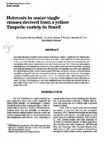Use este identificador para citar ou linkar para este item:
http://biblioteca.incaper.es.gov.br/digital/handle/item/550Registro completo de metadados
| Campo DC | Valor | Idioma |
|---|---|---|
| dc.contributor.author | GAMA, E.E.G.e | pt_BR |
| dc.contributor.author | HALLAUER, A.R. | pt_BR |
| dc.contributor.author | FERRÃO, R. G. | pt_BR |
| dc.contributor.author | BARBOSA, D.M. | pt_BR |
| dc.contributor.other | Romário Gava Ferrão, Incaper. | pt_BR |
| dc.date.accessioned | 2015-01-14T12:02:20Z | - |
| dc.date.available | 2015-01-14T12:02:20Z | - |
| dc.date.created | 1995 | pt_BR |
| dc.date.issued | 2015-01-14 | pt_BR |
| dc.identifier.other | 5014 | pt_BR |
| dc.identifier.uri | http://biblioteca.incaper.es.gov.br/digital/handle/item/550 | - |
| dc.description | Most maize (Zea mays L.) crosses in Tropical regions use the heterotic pattern of Tupeno dent and Caribbean flint. Corsses between related lines are not used for commercial production. Related inbred lines are used in either double or three-way hybrids with other unrelated lines to develop superior hybrids. This study was conducted to determine the combining ability among 11 related inbred lines from a Tuxpeno population. The 11 inbred lines were crossed in a diallel series and were evaluated at six locations. A combinig ability analysis was made for grain yeild. The average yield across environments for the 55 single (44.8 q/ha) was not comparable to that of the single-cross hybrid (56.5 q/ha), induced as check. General combining ability (GCA) effects and specific combining ability (SCA) effects were highly significant (P < 0.01). Variation due to GCA, however, accounted for 68% of the variation among crosses. Indicating that additive genetic effects were more important than nonadditive effects. Highly significantly positive GCA effects were observed for lines 6 (2.44 q/ha) and 7 (6.40 q/ha) and highly significantly negative GCA effects for lines 5 (1.63 q/ha), 10 (2.64 q/ha), and 11 (4,01 q/ha). Significantly positive SCA effects were observed with line 4 x line 11, line 5 x line 9, and line 5 x 11 crosses. Lines 6 and 7 may have potential use as parents for three-way or double-cross hybrids. | pt_BR |
| dc.language | pt_BR | pt_BR |
| dc.publisher | Revista Brasileira de Genética, Ribeirão Preto v. 18, n. 1, p. 81-85, 1995. | pt_BR |
| dc.subject | Breeding | pt_BR |
| dc.subject | Heterose | pt_BR |
| dc.subject | Heterosis | pt_BR |
| dc.subject | Maize | pt_BR |
| dc.subject | Melhoramento | pt_BR |
| dc.subject | Milho | pt_BR |
| dc.subject | Zea mays | pt_BR |
| dc.title | Heterosis in maize single crosses derived from a yellow Tuxpeño variety in Brazil. | pt_BR |
| dc.type | -- | pt_BR |
| dc.ainfo.id | 4917 | pt_BR |
| dc.ainfo.lastupdate | 2015-01-14 | pt_BR |
| dc.ainfo.depositante | Merielem Frasson | pt_BR |
| Aparece nas coleções: | Memória Técnica do Incaper  | |
Arquivos associados a este item:
| Arquivo | Descrição | Tamanho | Formato | |
|---|---|---|---|---|
| 1995-Heterosis-in-Maize-Single-Crosses.pdf | 1,44 MB | Adobe PDF |  Visualizar/Abrir |
Os itens no repositório estão protegidos por copyright, com todos os direitos reservados, salvo quando é indicado o contrário.
